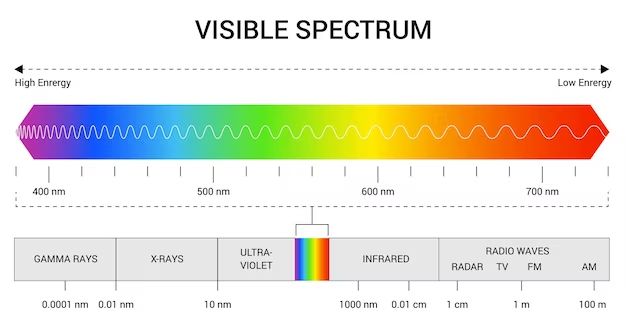The visible light spectrum that humans can see ranges from violet to red. Within this range, there are a variety of colors with different wavelengths. Determining which color is the “brightest” depends on how brightness is defined and measured.
Visible light is part of the electromagnetic spectrum that can be detected by the human eye. The visible spectrum ranges in wavelength from about 380-750 nanometers (nm) and in color from violet to red. Each color has a specific wavelength range within the visible spectrum:
| Color | Wavelength range (nm) |
| Violet | 380-450 |
| Blue | 450-495 |
| Green | 495-570 |
| Yellow | 570-590 |
| Orange | 590-620 |
| Red | 620-750 |
But within this spectrum, which color appears the brightest to our eyes? The answer depends on how we define “brightness” and how we measure it.
Defining Brightness
When it comes to visible light, brightness can be defined in a few different ways:
- Radiant intensity – The power emitted by a light source per unit solid angle in a given direction, measured in watts per steradian (W/sr). This measures the concentration of light in a beam.
- Luminous intensity – The amount of visible light emitted by a source, weighted by the eye’s sensitivity to different wavelengths. Measured in candela (cd).
- Luminance – The intensity of light per unit area in a given direction, measured in candela per square meter (cd/m2). Describes the amount of light passing through or reflected by a surface.
- Luminous flux – The total amount of visible light emitted by a source, measured in lumens (lm).
For determining the “brightest” color, luminous intensity and luminance are the most relevant quantities to consider. They indicate how bright the light appears to the human eye.
Luminous Intensity by Wavelength
The following chart shows the luminous intensity per unit wavelength across the visible spectrum, under equal radiant power conditions:

As seen on the graph, the luminous intensity peaks at around 555 nm, which corresponds to green-yellow light. The human eye is most sensitive to light at this wavelength.
Under equal radiant power across the spectrum, green-yellow light at 555 nm will appear brightest to our eyes. But we also need to consider the luminance emitted by real light sources.
Luminance of Different Light Sources
While green-yellow light has the highest potential luminous intensity, the peak wavelength and luminance emitted by real light sources can vary depending on the temperature and construction of the source.
Here are examples of the luminance produced by common light sources at their typical operating temperatures:
| Light Source | Approx. Temperature | Peak Wavelength | Luminance (cd/m2) |
|---|---|---|---|
| Candle | 1900 K | 850 nm (near-infrared) | 1 |
| Incandescent bulb | 2800 K | 1000 nm (near-infrared) | 15 |
| Mercury vapor lamp | 4000 K | 545 nm (green) | 100 |
| Xenon arc lamp | 6000 K | 550 nm (green-yellow) | 300 |
| Direct sunlight | 5700 K | 575 nm (yellow) | 100,000 |
As shown in the table, high-temperature light sources like sunlight, xenon lamps, and mercury lamps emit light concentrated near the peak sensitivity of human vision. This results in a higher luminance output.
Conclusion
In summary, while green-yellow light around 555 nm has the highest potential luminous intensity, the brightest real light source to human eyes is direct sunlight peaking at 575 nm yellow. With a luminance of 100,000 cd/m2, sunlight far exceeds any artificial light in brightness.
Other high-temperature light sources like xenon, mercury, and metal halide lamps can come close to sunlight in luminance by concentrating their emission near the green-yellow peak sensitivity of human vision. So while pure yellow-green light is intrinsically the brightest, natural and artificial illumination sources that emit strongly in this range will appear the brightest to our eyes.
When designing bright illumination or camera/display color calibration, the yellow-green region from 550-575 nm is most effective for maximizing perceived brightness.
But luminance and brightness perception can also depend on the intensity distribution, surrounding conditions, and other complex factors. Further research and measurements are needed to fully understand what makes light appear brightest to human vision across different situations.


